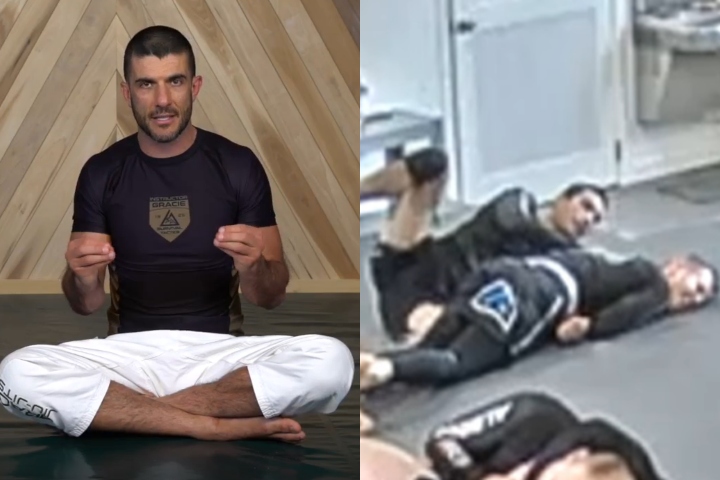The incident which left Jack Greener, BJJ white belt student – as well as the jury’s decision to award Greener $46 million – has stirred up a lot of controversy.
Controversy, which was further magnified with Rener Gracie’s post; in which he explained that he gave testimony during the case, as an expert witness.
A part of the BJJ community grew agitated with Rener’s take on the unfortunate event, blaming him that he is taking advantage of it for his own profit.
And now, the famous Gracie posted a 20-minute Instagram video, in which he provided further explanation of his testimony.
BJJEE has transcribed some of the most important parts of it. Here’s what Rener had to say:
I wanna start by saying that this incident was a tragedy for everyone involved. At no point during the process was I asked to give an opinion on the intent of Mr Iturralde – nor do I have one.
I recognize fully that a mistake can be made and there have been no malice intended.
I also recognize that it’s possible to make an honest mistake and still be held liable to those who the mistake adversely affected.You could be driving your car, get distracted on your phone, cause an accident that injures someone… And even though it was a mistake and there was no ill intent, you may still be held liable for the injuries that the accident caused.
Rener explained that the technique attempted was Leo Vieira’s rolling back take from Turtle position.
And that there are two ways to apply it correctly:
When applied correctly, this technique directs the recipient of the technique over one of their shoulders, or directly over their head.
But when applied incorrectly, the consequences can be devastating.When correctly applied, the technique can be applied from a body lock – where both arms are underneath the recipient’s armpits.
Or, it can be done with an over-under grip configuration – or Seatbelt configuration – one arm over the neck and shoulder of the recipient and the other arm under their opposite armpit.
Rener then went on to demonstrate both variations of the technique.
He then presented the video of the incident, where the injury took place, albeit with a small variation.
In this video, both the coach’s and student’s arms are marked with different colors; so that the location and type of grips used by the coach would be more easily distinguishable.
The analysis of the video shows that the coach wasn’t applying either of the two above-mentioned “correct” grips, but that he had one of Greener’s arms trapped with a grip over it.
This resulted in the coach binding the student’s left arm to their rib cage, completely removing the arm from the grapple:
Rener explained that this made it impossible for the coach to do a very important thing: to position his shoulder at the back of the student’s head.
This objective can be fulfilled in the two correct versions of executing the move which, ultimately, tuck the other person’s head during the forward roll.
Therefore, “I” have no control of the recipient’s head during this technique.
And as we know [as he’s demonstrated earlier in the video], head control is the number one prerequisite for the safe application of the rolling back take.
Additionally, the grip configuration has made it impossible for the student to support their bodyweight – to post properly, thus lessening the pressure on his neck:
Having the arm trapped and not having the head control with your shoulder, to essentially force the person to roll safely with the technique – that level of certainty and control you don’t have when you don’t have the shoulder at the back of the neck.
And then, add to the fact that if things do go wrong, they don’t even have the hand to be able to support themselves – and protect their neck from folding or their torso from going in the wrong direction and guide themselves in the safer direction.
They simply don’t have that privilege when their arm is essentially strapped down to their body.
Rener also gave an explanation of using the term “spike” in his original Instagram post:
Mr Iturralde went into a full headstand, with Mr Greener’s arm restricted, placing all the weight of both of their bodies directly on his head and neck.
And this is where the term “spike” entered into my descriptive equation. And now I understand that, without clear context, that word can be confusing and misleading. And that was by no means my intent.Even though the technique used was not a spike in the literal Jiu-Jitsu definition of the sense, the effect that this technique – incorrectly applied on Greener’s head and neck – was comparable to someone being spiked on their head.
Rener also emphasized that Mr Iturralde’s testimony was also consistent with most of his opinions about the case. Among of them being:
…An instructor must maintain control over their student when executing techniques that endanger the spine.
Number five: the instructor must maintain control over themselves when executing the techniques which endanger the spine.
Number six: the instructor should not execute the technique that can paralyze a student, unless they are self-aware that they can do it safely.Mr Iturralde also admitted that the grip he utilized disabled Mr Greener’s left arm; that he lost control over Mr Greener’s head and neck; and that he had no control over himself – which ultimately in Mr Greener’s catastrophic injury.
Rener continued by pointing out the preventable nature of the incident:
All of this points to the fact that this was a preventable tragedy.
The video makes very clear how and why Mr Iturralde lost control – because he used the wrong grip configuration. Which ultimately left Mr Greener’s head and neck exposed.
And this happened well before the initiation of the forward roll. So, there was an opportunity to correct the grip, before initiating the technique.
He also mentioned that the technique used wasn’t taught in the school beforehand:
It was also brought up during trial that the technique used by Mr Iturralde on the day of the incident had never been taught at Del Mar Jiu-Jitsu [the BJJ school].
Towards the end of the video, Rener reiterated what his role was during the testimony and what he formed his opinions around:
Now, the bulk of my testimony was centered around the question of whether or not Mr Iturralde unreasonably increased the risk to Mr Greener.
And to be clear, malice or intent of Mr Iturralde were not issues that I was called to render an opinion on.Rather, my testimony was that this technique should not be used on white belts, at full intensity, by black belt instructors.
Because, even when applied correctly, there still is a risk of injury if the person receiving the technique isn’t expecting it.Now, I know that Mr Greener had a history of competing as a white belt.
But even still, the gap between a white belt and a black belt is massive.Number two: the student should be taught the technique before that technique gets used on them at full intensity in live sparring.
Particularly when a technique has such a slim margin for error, like this one does.Number three: if at any point, during any technique, a black belt instructor feels a shift in the position or in the grip, such that the risk of the injury to the recipient has gone up in the middle of the technique, the instructor should abort the technique.
Ultimately, it was the failure to take any of these precautions that unreasonably increased the risk of injury to Mr Greener.
Watch the full video below:
View this post on Instagram
However, a part of the BJJ community continues to criticize Rener for his takes.
Here’s one, from Dan Lukehart – who also claims to have read “Rener’s deposition in full”:
How much of the video did you see him discussing the points of how he portrayed BJJ and what the standards of practice are that are contained in the post I’m sharing? None.
And that stuff was used in the judgement and the stuff that matters from the legal standpoint.
In the court he speaks one way, on the video to the grappling community another. When he speaks to us, he hides what he knows will be controversial.
Did Rener talk about how he painted schools that didn’t have an intro lesson followed by a beginner course as dangerous? Did you miss how he painted a picture of how it’s not normal to do the same techniques in rolling that we do in competition?
I feel like I’m in an alternate Rener reality hell when people are agreeing with what he did AT THE TRIAL….not on Instagram.
Here’s what I have read…I have read Reners deposition in full. It’s full of “extreme departures of industry standard” this and “pursuant to industry standards” that.
All of which would make a “sport BJJ practitioner” upset.The description of the technique here is, “Instead, of performing a routine and safe back take, Mr. Iturralde pinned Mr.Greener to the mat, put all his pressure on Mr. Greener’s neck and jumped with both feet in the air, attempting to perform a front-flip.”
Read Lukehart’s entire take on the following link.

















